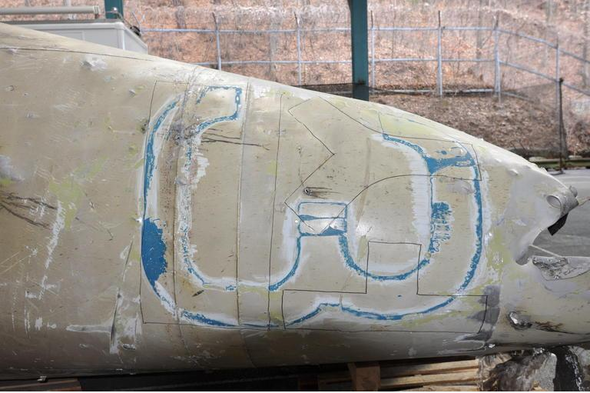hankyoreh
Links to other country sites 다른 나라 사이트 링크
North Korea’s recent rocket was same type as Dec. 2012 launch

It was confirmed that the long-range rocket that North Korea fired on Feb. 7 was essentially the same type of rocket as the Eunha-3 fired in Dec. 2012.
“The long-range missile that was fired recently and the long-range missile that was fired in 2012 were found to be identical in all comparable respects, including the first-stage engine nozzle, the length and diameter of the middle stage and the acceleration motor that we recovered,” a military expert who is familiar with the analysis of the debris of the long-range rockets told reporters on Apr. 27. “The two appear to be nearly the same kind of rocket.”
“When we peeled off the paint on the fuel tank that we recovered, we found the number ‘3.’ This suggests that it is very likely that the missile fuselage was painted over where it originally said ‘Eunha-3,’” the expert said.
“We confirmed that anti-corrosive fluoride components were added to the oxidizer, something that we did not find in the 2012 debris,” the expert added.
Before North Korea launched the missile this past February, it raised the gantry at the launchpad from 50m to 67m, raising expectations that it would fire a bigger missile. North Korea also referred to this rocket not as “Eunha-3” but as “Gwangmyeongseong,” creating the impression that it was a different kind of rocket.
The actual trajectory of the rocket launched in February was similar to that of the Eunha-3 in 2012, leading some to suggest that it was likely the same kind of rocket. But this is the first confirmation that the two rockets are of the same type.
This indicates that North Korea has made no major improvements in its missile technology over the past three years.
“There may not be any new technology, but the fact that two consecutive launches have been successful can be seen as an improvement in the reliability of the existing technology,” the expert said.
South Korean military officials analyzed the payload fairing (the nose cone used to protect the satellite) of the North Korean rocket, which they managed to recover for the first time.
“In the payload fairing, we did not find any of the collision prevention or sound reduction equipment necessary to protect the satellite. This provides grounds for thinking that this launch was not about putting a satellite into orbit, as North Korea claims, but rather about developing ballistic missile technology,” the expert said. The lack of this equipment, the expert said, shows that North Korea did not take the trouble to protect the satellite.
“The inside of the fairing was blackened by an explosion at the time of the fairing separation. There is so much soot here that some could also have gotten inside the solar panel on the satellite, which was inside the fairing, and caused a malfunction,” the expert said. “In fact, while the satellite entered orbit on Feb. 7, no signals have been detected from it since Feb. 10. A malfunction of the solar cell could have interrupted the power supply.”
During the rocket launch in February, North Korea detonated the first stage of the rocket after it separated from the rest of the rocket. At the time, around 270 fragments of the first stage fell into the ocean off the west and southern coast of South Korea.
Through three search missions, the South Korean navy managed to recover a number of pieces of the rocket, including the payload fairing, fuel tank, engine nozzle and turbo pump.
By Park Byong-su, senior staff writer
Please direct questions or comments to [english@hani.co.kr]

Editorial・opinion
![[Column] Has Korea, too, crossed the Rubicon on China? [Column] Has Korea, too, crossed the Rubicon on China?](https://flexible.img.hani.co.kr/flexible/normal/500/300/imgdb/original/2024/0419/9317135153409185.jpg) [Column] Has Korea, too, crossed the Rubicon on China?
[Column] Has Korea, too, crossed the Rubicon on China?![[Correspondent’s column] In Japan’s alliance with US, echoes of its past alliances with UK [Correspondent’s column] In Japan’s alliance with US, echoes of its past alliances with UK](https://flexible.img.hani.co.kr/flexible/normal/500/300/imgdb/original/2024/0419/2317135166563519.jpg) [Correspondent’s column] In Japan’s alliance with US, echoes of its past alliances with UK
[Correspondent’s column] In Japan’s alliance with US, echoes of its past alliances with UK- [Editorial] Does Yoon think the Korean public is wrong?
- [Editorial] As it bolsters its alliance with US, Japan must be accountable for past
- [Guest essay] Amending the Constitution is Yoon’s key to leaving office in public’s good graces
- [Editorial] 10 years on, lessons of Sewol tragedy must never be forgotten
- [Column] A death blow to Korea’s prosecutor politics
- [Correspondent’s column] The US and the end of Japanese pacifism
- [Guest essay] How Korea turned its trainee doctors into monsters
- [Guest essay] As someone who helped forge Seoul-Moscow ties, their status today troubles me
Most viewed articles
- 1[Column] The clock is ticking for Korea’s first lady
- 2Samsung barricades office as unionized workers strike for better conditions
- 3[Editorial] When the choice is kids or career, Korea will never overcome birth rate woes
- 4[News analysis] After elections, prosecutorial reform will likely make legislative agenda
- 5S. Korea, Japan reaffirm commitment to strengthening trilateral ties with US
- 6All eyes on Xiaomi after it pulls off EV that Apple couldn’t
- 7After 2 months of delayed, denied medical care, Koreans worry worst may be yet to come
- 8US overtakes China as Korea’s top export market, prompting trade sanction jitters
- 9[Column] Has Korea, too, crossed the Rubicon on China?
- 10Hong Se-hwa, voice for tolerance whose memoir of exile touched a chord, dies at 76